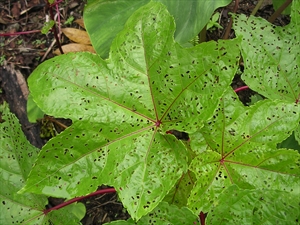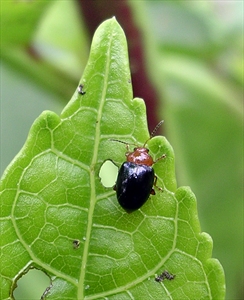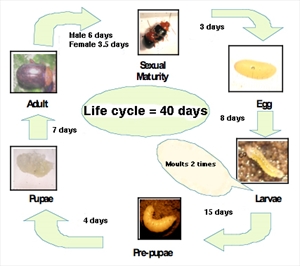There is no common name, but bele flea beetle, Abelmoschus flea beetle, aibika flea beetle sliperi kabis flea beetle would all be suitable.
Pacific Pests, Pathogens and Weeds - Online edition
Pacific Pests, Pathogens & Weeds
Bele (Abelmoschus) flea beetle (022)
Nisotra basselae
The beetle is endemic to Papua New Guinea, and in 1984 spread to Solomon Islands.
Bele (aibika, sliperi kabis, island cabbage, Abelmoschus manihot), possibly Hibiscus tilaceous (under lab conditions, but not seen in the field); not on Sida, nor the garden hibiscus, Hibiscus rosa-sinensis.
Adult beetles feed on leaves creating many small (1-5 mm diameter) holes (Photo 1). Eggs are laid singly or in small batches just below the surface of the soil, near the stem. They hatch after 8-9 days, and the larvae remain in the soil for 12-18 days feeding on small roots. They moult twice before they pupate for 4-6 days. Adults emerge from the soil (Photo 2). Males emerge first, taking 6-8 days to become sexually mature; females take 3-5 days. The entire life cycle takes about 40 days (Diagram). The adults disperse by walking, jumping and flying. The number of generations per year is unknown.
The damage is so severe that in many places in Solomon Islands people have stopped growing bele. The larvae feed on small roots, especially the tiny root hairs. Whether this affects the growth of the plant is unknown.
Look for small holes in the leaves and the presence of beetles. The adult beetles are about 4 mm long and can be found on both sides of the leaves. The head and part of the section below are orange/brown, and the wing cases are black. The beetles are less obvious during the hotter times of the day, when they move under the leaves.
QUARANTINE
Some of the more isolated parts of the Solomon Islands are free from the beetle, e.g., the provinces of Rennell and Bellona, and Temotu. Therefore, no leaves of bele or other parts of the plant should be taken there. Extension services should constantly remind people of this, with messages on radio and in newspapers.
NATURAL ENEMIES
Parasites of the adults include nematode worms and mites. The adults do not seem to be affected by the presence of the fire ant, Wasmannia auropunctata. Nisotra may be toxic to visual predators, like birds and lizards.
CULTURAL CONTROL
There are a number of possibilities:
Before planting:
- Plant bele far from plants infested with the beetle; the beetles do not fly long distances.
- There is some evidence that planting in clover reduces infestations.
- Plants grown under shade may have fewer beetles; however, too much shade gives poor plant growth.
- Plant more bele in the wet season when beetle numbers are lower.
During growth:
- Hand pick the beetles when infestations have just started; this will delay beetle populations reaching damaging numbers later.
- Cultivate the soil at the base of the plants to expose eggs, larvae and pupae to the sun and predators.
- Apply thick mulches of straw, sacks, grass or other organic materials (several centimetres thick); these may prevent female beetles from laying eggs at the base of the stems.
- Use horticultural glue bands around the stems. The glue is a non-drying sticky substance made from natural gum resins, vegetable oil and wax that prevents crawling insects from reaching the soil. One such product is called "Tanglefoot".
After harvest:
- Collect debris and burn it when plants have become old and harvests of leaves are no longer worthwhile.
CHEMICAL CONTROL
- Use plant-derived products, such as derris, pyrethrum or chilli (with the addition of soap).
- Note, a variety of Derris, brought many years ago to Solomon Islands from Papua New Guinea, is effective as a spray. It contains rotenone, an insecticide, so it should be used with caution. There may be varieties of Derris (fish poisons) in your country that can be tried (see Fact Sheet no. 56).
- Orthene (acephate) is used in Solomon Islands; other insecticides, such as synthetic pyrethroids are likely to be effective and safer.
____________________
When using a pesticide, always wear protective clothing and follow the instructions on the product label, such as dosage, timing of application, and pre-harvest interval. Recommendations will vary with the crop and system of cultivation. Expert advice on the most appropriate pesticides to use should always be sought from local agricultural authorities.
AUTHORS Helen Tsatsia & Grahame Jackson
Information from (including Diagram) Maclean V, Entomologist, SPC, and Chris Reid, Principal Research Scientist, Entomology, Australian Museum, Sydney.
Produced with support from the Australian Centre for International Agricultural Research under project PC/2010/090: Strengthening integrated crop management research in the Pacific Islands in support of sustainable intensification of high-value crop production, implemented by the University of Queensland and the Secretariat of the Pacific Community.






